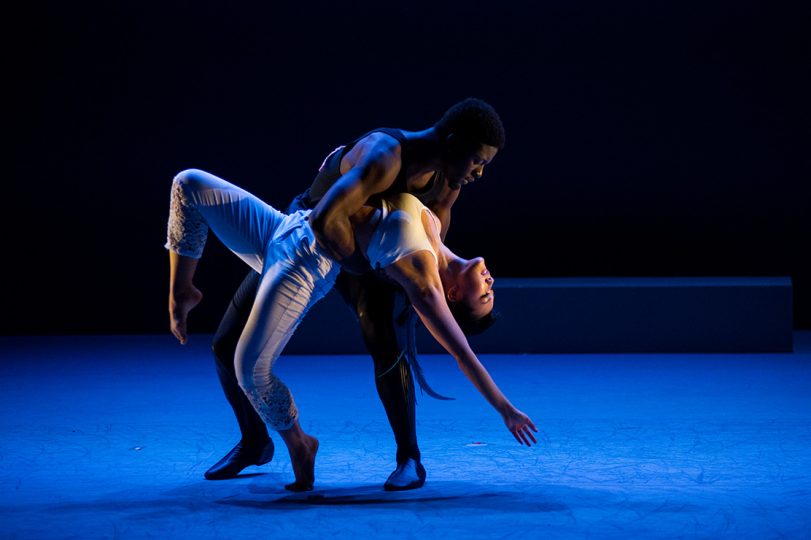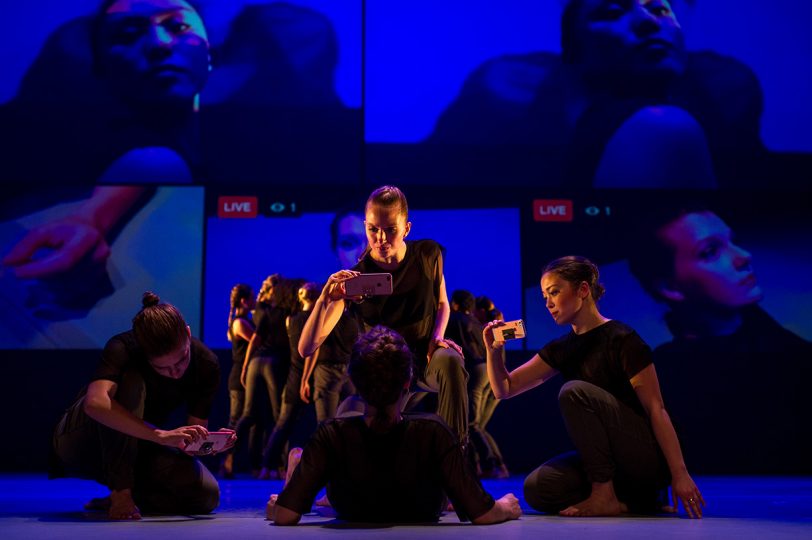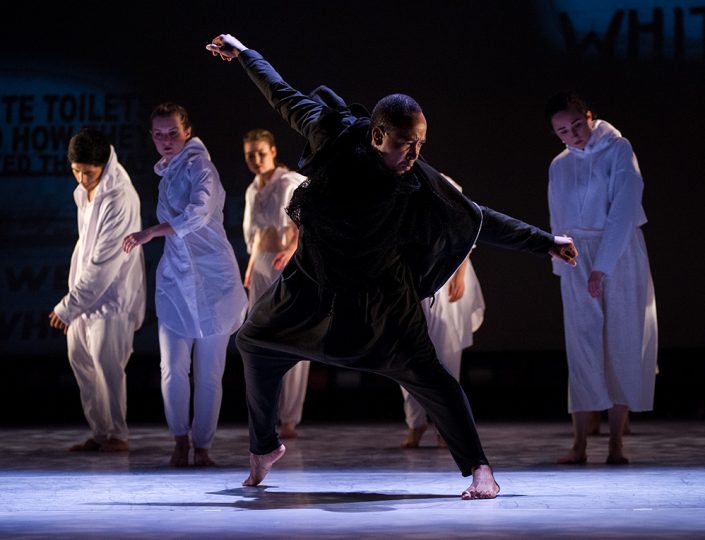Artistic directors Jeremy Arnold, Erica Gionfriddo and Dorothy O’Shea Overbey discuss Fall For Dance and their choreographic works which seek to define the term “artist-citizen,” and address the larger issues facing our society today.
“At this moment in history, it becomes ever more important for the arts to serve as a vehicle for communication, connection and action. In this department, we recognize theatre and dance, collectively, as a medium for learning citizenship. Our mission is to cultivate artist-citizens by encouraging students to position their work and development within broad social contexts and instill a deep appreciation for the role that dance plays in human culture around the world. These pieces have asked them to consider viewpoints both deep within and far beyond their personal experiences in order to reflect on individuality and belonging as they navigate layers of self in an increasingly media-centric world. They have explored lineage and heritage as well as cultures and practices unfamiliar to them in an effort to recognize that each of us is part of a complex history that must be considered as a whole in order to understand our relationships with others.
The work you will see on stage is the result of young people engaging with their world; a process that has further equipped them to participate in and facilitate change within the world. We’ve asked these artists not just to dance “about” something, but to live with it, interact with it, research it outside of the studio and bring their findings into the work of creating. As a result of this investigation, the work itself can affect not only the performers and the audience, but each person they communicate with. In this way, artist-citizens are not merely reflecting their reality, but directly shaping it.”
– Jeremy Arnold, Erica Gionfriddo and Dorothy O’Shea Overbey (co-artistic directors)

Each of the three artistic directors will present their own choreography as part of Fall For Dance, exploring the concepts of identity, cultural experience and self-expression through contemporary ballet and innovative choreography.
“Crone is an ambitious project. This narrative dance work is one stage of a process that began with a concert of the dance’s original score for 23-piece orchestra, and will culminate in the making of a virtual reality dance film,” explains artistic director and choreographer, Dorothy O’Shea Overbey.
Conceived and choreographed by Dorothy O’Shea Overbey, this is a story about a young woman who loses everything and is faced with a choice between forgiveness and revenge. The narrative takes place in the context of two societies: one that lives in harmony with themselves and their environment, and another whose members have given up their free will for a sense of belonging.
“There will be a live orchestra for this concert, a tremendous opportunity for dancers to learn on-stage, real-time communication with a conductor. This whole process has been a deep-dive in to the art of collaboration: dancers (and even the composer!) have helped generate movement, the choreographer has participated in design and music composition, and designers have shed light on subtleties of character development,” says O’Shea Overbey.
“This production is also a workshop of sorts for the upcoming virtual reality film: our group of artist collaborators at UT is embracing the technology of this virtual reality and creating a template for artists of all kinds to reach their audiences in this exciting new medium.”
While Crone is a narrative ballet, In The Ether, choreographed by Erica Gionfriddo, is an experiment actively integrating live-streaming with live performance. “My investigation of this hybrid form began in 2016, when Facebook, Instagram and other popular social media apps suddenly gave everyone live, intimate windows into millions moments taking place around the world, from banal to devastating,” explains Gionfriddo. “I was fascinated by how deeply this changed our engagement with events about which we otherwise would have only read a news article, or never known about at all. This phenomenon of magnifying human experiences, combined with that of how profoundly social media can dictate one’s own decisions, self-image and connection to the world prompted my ongoing investigation of this now ubiquitous technological reality within the process of performing. The questions emerging from that research—how deeply does social media permeate our psyche, beyond the pleasure pings of “likes,” “comments,” or “shares?” How many versions of ourselves do we curate for these different platforms? How many additional “filters” do we put our experiences through when we chose to post something online? How many different types of relationships must we navigate to include this large virtual audience? If we have additional information about a friend, acquaintance, or stranger via social media, do we actually have any kind of closer human connection?”

Gionfriddo’s work focuses on the integration of technology as a means to discover inherent truths we all share. “It has been inspiring to see these young women face this complex issue head-on and dive into exploration of their own actions both in and out of the studio. We believe the mechanics of the piece will simultaneously feel familiar to audiences and make them more aware of our relationship to our devices. And while we invite audiences near and far to experience the results of our experiment at bit.do/intheether-drt, we hope to inspire a moment of reflection about the act of posting, reacting, or sharing online.”
Artistic director Jeremey Arnold has joined forces with head of dance Charles O. Anderson to create the third installment of (Re)current Unrest pt. 3: Clapback. The third installment of this series of works explores the current state of “race relations” in the United States, centering specifically on the physicality of taking a knee as a way of “clapping back” (slang meaning ‘firing back when attacked’).

“In this piece we use one of Steve Reich’s vital musical works, Clapping Music,” shares Arnold. “In this minimalistic composition, two performers simultaneously clap one measure of eighth notes in a 6/4 time signature. One performer will repeat this pattern for the entirety of the song, while the other performer will shift his pattern by one eighth note every twelve measures until the pattern resolves and the two performers are back in unison. The result is twelve unique rhythms that become increasingly intricate and exciting. Since this is a section of a larger work, we largely pulled from Charles’ movement vocabulary. Charles would choreograph a sequence to another song, generally with a slower tempo and in a more common time signature. Following this, I would transpose the choreography into measures that lasted 6 notes. We found that by working this way, we could avoid falling into the predictable musical shifts that take place in Clapping Music. Additionally, Clapping Music at times is melodic and sonically pleasing and at other times busy and contradictory. We found this to be a fitting world for our choreography to live in.”
Fall For Dance takes the stage November 7-12, 2017 at the B. Iden Payne Theatre. Fall For Dance also features the work by guest artists Ray Schwartz (Director at Universidad de las Americas in Puebla, Mexico) and Jenn Freeman (New York-based choreographer, dancer and educator).
Fall For Dance
November 7-12, 2017
B. Iden Payne Theatre
Images: 1) (Re)current Unrest pt. 3: Clapback by Charles O. Anderson and Jeremy Arnold, 2) Crone by Dorothy O’Shea Overbey, 3) In the Ether by Erica Gionfriddo, 4) (Re)current Unrest pt. 3: Clapback by Charles O. Anderson and Jeremy Arnold
Photos by Lawrence Peart



